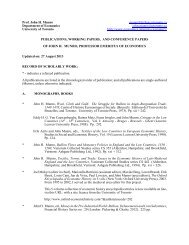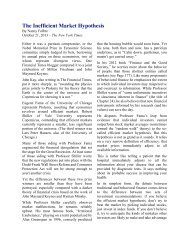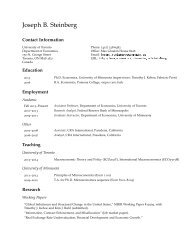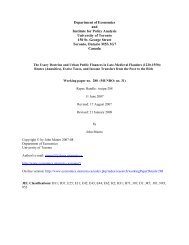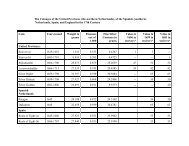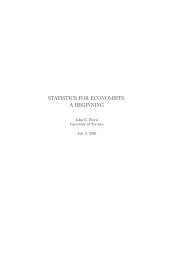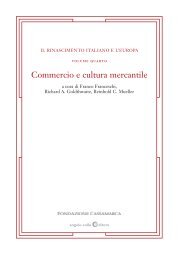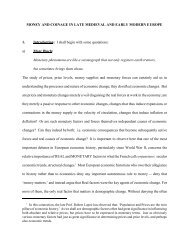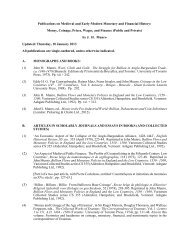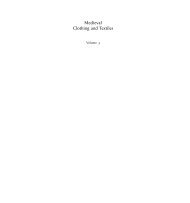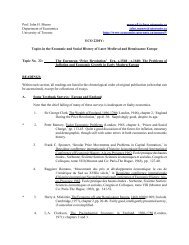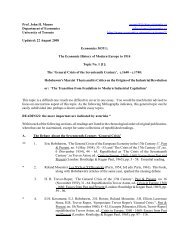Create successful ePaper yourself
Turn your PDF publications into a flip-book with our unique Google optimized e-Paper software.
477 scarlet<br />
specified in medieval regulations as unfulled and<br />
of long-staple wool, and followed a suggestion<br />
of Marta Hoffmann that they were also woven<br />
in balanced four-shed twill. They therefore<br />
considered that some of the 2 × 2 twills from<br />
→ London could have been says (and may also<br />
have been of a mixed spinning). The use of the<br />
word for fine worsteds and cloths mixed with<br />
worsteds seems to have increased late in, and after<br />
the end of, our period.<br />
The two meanings are difficult to distinguish<br />
in literature, except by context, which is probably<br />
why these words ultimately fell out of use, though<br />
say (wool) seems to have lasted longer than<br />
say (silk).<br />
The Anglo-Norman Dictionary’s suggestion of<br />
‘linen’ as a meaning seems entirely unfounded<br />
and is not supported by their own attestations.<br />
Bibliography<br />
Crowfoot, E., Pritchard, F. and Staniland,<br />
K., Textiles and Clothing c. 1150–c. 1450, Medieval<br />
Finds from Excavations in London 4 (London:<br />
1992), 40–1. Kurath, H., Kuhn, S.M.,<br />
Reidy, J. and Lewis, R.E., ed., The Middle English<br />
Dictionary (Ann Arbor, MI: 1952–2001), s.v. sai<br />
(n (2)), sai(e). Munro, J.H., ‘Three centuries of<br />
luxury textile consumption in the Low Countries<br />
and England, 1330–1570: trends and comparisons<br />
of real values of woollen broadcloths<br />
(then and now)’ in Ed. K. Vestergård Pedersen<br />
and M.-L.B. Nosch, The Medieval Broadcloth.<br />
Changing Trends in Fashions, Manufacturing<br />
and Consumption (Oxford: 2009), 1–73, at 9.<br />
Rothwell, W., Trotter, D., et al., ed., Anglo-<br />
Norman Dictionary, Publications of the Modern<br />
Humanities Research Association, 17 (I) (2005–),<br />
s.v. seie, saie1 . Walton, P. ‘Textiles’ in Ed.<br />
J. Blair and N. Ramsay, English Medieval Industries<br />
(London: 1991), 319–54, at 342.<br />
Mark Chambers<br />
Elizabeth Coatsworth<br />
Scabbard<br />
See → weapons as items of dress.<br />
Scarlet<br />
The medieval scarlet was a woollen textile and<br />
not originally a colour; subsequent use of the term<br />
‘scarlet’ as both a noun and adjective for that vivid<br />
red colour was derived from the textile’s name.<br />
None of the later medieval and modern European<br />
terms for ‘scarlet’, for either the textile or<br />
the colour (nouns and adjectives), has any antecedents<br />
in the ancient and early-medieval worlds.<br />
The first documented use of a word related to<br />
subsequent European nouns for the textile itself is<br />
found in the Old High German text Summarium<br />
Heinrici (1007–1032). In the section De diversitate<br />
vestimentorum, the author used the Old High<br />
German word Scarlachen to define a textile term<br />
from the still widely-used Etymologiarium of<br />
Isidore of Seville (570–636): ‘Ralla vel rullo quę<br />
vulgo rasilis dicitur’. Rasilis (from radere) meant<br />
‘scraped, smoothed, shaved’, and a later English<br />
medieval Latin word list defined ‘ralla’ as ‘shaving<br />
cloth’. Presumably the author of the Summarium<br />
meant a shorn cloth, because the OHG ‘schar’<br />
meant ‘shorn’ (from shearing: scheren, in modern<br />
German) and lach meant cloth (Tuch in modern<br />
German). Certainly this OHG word is the source<br />
of subsequent medieval and modern terms for<br />
scarlet in many Germanic languages. In Middle<br />
English texts, it appears in a wide variety of forms<br />
(influenced by Romance as well as Germanic<br />
languages): scharlette, scarlatte, skarlote, skarlet,<br />
scarlat, and scarlet.<br />
This etymology, beginning with the OHG<br />
Summarium Heinrici, seems to support a longfavoured<br />
explanation for the true essence of<br />
the medieval scarlet: as a very fine → woollen<br />
→ broadcloth, subjected to repeated shearings.<br />
The theory was first proposed by Henri Pirenne<br />
and then elaborated by Jean-Baptiste Weckerlin<br />
in Le drap ‘escarlate’ au moyen âge (1905).<br />
Both Pirenne and Weckerlin observed that the<br />
medieval Flemish term scharlaken or scaerlaken<br />
was composed of two substantives: schar—shear<br />
(from scheren: to shear a cloth) and laken—cloth<br />
(in both medieval Flemish and modern Dutch).<br />
That explanation does not differ in any essentials<br />
from the interpretation of the OHG Scarlachen or<br />
sharlachen given here; and it is important to note<br />
that this OHG text was unknown to both Pirenne<br />
and Weckerlin.<br />
In their view, the most luxurious and most<br />
costly of all medieval woollens were those that<br />
were highly shorn; and only those woollens made<br />
from the finest English → wools, then the world’s<br />
best, could undergo such thorough, intensive<br />
shearings. Further observing that Flemish towns<br />
dominated the manufacture and international<br />
trade in fine woollens from the 11th to 14th centuries,<br />
they concluded that their cloth merchants
scarlet 478<br />
had succeeded in imposing this Flemish term on,<br />
not just Germanic, but virtually all West European<br />
languages, even if Latin and Romance forms of<br />
the term came to diverge from the Germanic<br />
terms, especially in their endings or suffixes.<br />
Finally, well-known medieval descriptions of<br />
this textile in a wide range of colours—not just<br />
scarlet-red—further convinced them that the<br />
medieval textile owed both its name and its value<br />
to this extensive shearing. To explain how the<br />
colour term ‘scarlet’ arose and how it came to be<br />
linked to the textile, Weckerlin offered the following<br />
simple hypothesis (not based on any textual<br />
evidence): since the colour scarlet, in medieval<br />
Europe, symbolized both divinity and regal,<br />
indeed imperial, supremacy—as indeed still the<br />
preferred colour for robes of the papal curia—<br />
international cloth merchants eventually insisted<br />
that all scarlets, as the luxury cloth sans pareil, be<br />
dyed exclusively with the agent that produced<br />
that regal colour.<br />
Seductive and enduring as the Pirenne-Weckerlin<br />
hypothesis may be, it raises a number of<br />
serious problems. The first is the inconvenient<br />
fact that those who dominated the cloth industry<br />
and international trade of Flanders, especially at<br />
the renowned Champagne Fairs, from the 11th to<br />
early 14th centuries, were chiefly francophones:<br />
from Arras, Douai, and Lille in particular. It is<br />
highly improbable that they and the Italian merchants<br />
with whom they dealt would have adopted<br />
a linguistically awkward Flemish term. The second<br />
is that Romance-language terms for ‘scarlet’,<br />
and the English term, differ in significant respects<br />
from the Germanic forms.<br />
The most serious flaw, however, is the contention<br />
that the high cost and high value of scarlet<br />
lay in their shearing processes, for ‘scarlets’ were<br />
subjected to shearing processes that did not differ<br />
in quality, skill, or frequency, and certainly not in<br />
relative costs, from the finishing processes for any<br />
other fine woollen textiles. Moreover these costs<br />
rarely accounted for more than 2.5–3.5% of the<br />
wholesale price.<br />
Rather, the origin of the Germanic names for<br />
scarlet, commencing with the OHG scharlachen<br />
in the Summarium Heinrici, likely refers to the<br />
novel textile product of the recently introduced<br />
horizontal treadle → loom, first described in<br />
a mid-11th-century Talmudic commentary by<br />
Rabbi Solomon Izhaqi (Rashi of Troyes, c. 1040–<br />
1105). This new loom ultimately displaced the<br />
traditional vertical loom, which produced essentially<br />
light worsted fabrics, producing instead a<br />
radically different cloth: the first genuine heavyweight<br />
woollens. They differed from → worsteds<br />
in being extensively fulled and subjected to finishing<br />
processes including being repeatedly teaselled<br />
and shorn (scharlachen), with foot-long<br />
razor-sharp steel shears, to remove the ungainly<br />
nap of the fulled, tentered cloth, thereby obliterating<br />
the patterns, which were visible in medieval<br />
(unshorn) textiles. The result was a texture often<br />
as fine as silk: hence the significance of shearing,<br />
in OHG schar-lachen, and in the Germanic textile<br />
terms that evolved from it.<br />
From about the same time as the Summarium<br />
Heinrici may be found the first use of the term<br />
‘scarlet’ in a Latin text, according to Weckerlin<br />
c. 1050, but used as an adjective: ‘tres pannos scarlitinos<br />
anglicanos’. His source cannot, however,<br />
be found; the next oldest known text comes from<br />
a Cluny abbey charter of c. 1100, used as noun—<br />
and one linked to the red colour: ‘de scarlata rubea<br />
tunicam’. Other less common medieval Latin<br />
forms are: scarlatum, scarletum, scarlaccum, scarlateus,<br />
scarletus, escallata, escarlata, escarletum,<br />
squallata. Subsequently, variants of these terms<br />
were adopted by all the Romance languages.<br />
While the Latin and most of the Romance terms<br />
retain the ‘scar’ prefix of the Germanic terms, they<br />
all contain ‘lat’ in the ending or suffix—missing in<br />
the Germanic languages (except English).<br />
The probable origin of that ‘lat’ suffix is the Arabic<br />
name for a widely-manufactured and -traded<br />
textile dating from about the 9th century, of<br />
which the principal feature was its scarlet colour:<br />
siklāt (later and then more commonly siklātūn).<br />
Many dictionaries still favour, as the origin of the<br />
European terms for ‘scarlet’, the Persian (Farsi)<br />
word sakirlāt; but the first Persian usage cannot<br />
be dated earlier than c. 1290. Almost certainly<br />
derived from the Arabic siklātūn, the Persian<br />
sakirlāt was likely also influenced in its formation<br />
by extensive Italian commerce in 13th-century<br />
Persia, and hence by the Italian word scarlatto.<br />
The problem, however, in trying to establish the<br />
Arabic term siklāt as an origin, or ancillary influence,<br />
for the Romance-language terms for ‘scarlet’,<br />
is that these Islamic textiles were all silks.<br />
Some philologists now contend, however, that<br />
the Arabic term was itself derived from the Late<br />
Roman term sigillatus or Byzantine Greek word<br />
σιγιλλατον: which was indeed a luxury and a royal
479 scarlet<br />
woollen textile, one decorated with seals or rings<br />
(sigilla: seal).<br />
Clearly, however, the distinguishing feature of<br />
the Islamic siklātūn (and Persian sakirlāt) silks<br />
was that they were very high-priced, luxury textiles<br />
dyed scarlet-red in → kermes. The principal<br />
centre of Muslim Spanish production of these<br />
luxury silk textiles, from at least the 11th century,<br />
was Almería, in southern Andalusia, a region rich<br />
in and renowned for kermes, undoubtedly the<br />
most costly dyestuff in medieval Europe. It could<br />
account for more than 50% of the wholesale price<br />
of broadcloth. The next most costly components<br />
of these scarlets were the wools. The best English<br />
wools were used (see → woollens) chiefly those<br />
from the Welsh Marches (Herefordshire and<br />
Shropshire), the Cotswolds and Lincolnshire.<br />
By far the least costly component was labour;<br />
the combined labour costs of finishing (dyeing,<br />
teaselling, shearing) was usually less than 3.45%.<br />
Perhaps the best way of representing the total<br />
costs and wholesale prices of these ultra-luxury<br />
textiles is to compare them with the daily wages<br />
of medieval skilled artisans. In London, in the<br />
1430s and 1440s, the most expensive scarlets were<br />
priced at £28 10s 0d sterling: the equivalent of 855<br />
days’ wages for a London master mason (8d per<br />
day) and 1,140 days’ wages (5.43 years) for an<br />
Oxford-Cambridge master mason (6d per day).<br />
The medieval scarlets were, therefore, indisputably<br />
the most costly and luxurious textiles manufactured<br />
in western Europe, rivalled only by some<br />
imported Asian silks. Equally indisputable is the<br />
fact that they owed their luxury value and high<br />
cost primarily to the kermes dyestuff, and secondarily<br />
to their English wools.<br />
The seeming paradox of references to scarlets<br />
variously described as brown, perse (a blue-greyish<br />
or ashen purple), murrey (mulberry), sanguine<br />
(bluish red) and even green and white can<br />
be explained by the fact that drapery records and<br />
town accounts in the Low Countries present a tripartite<br />
category for their woollens: medleys (see<br />
→ medlee), blues, and whites. ‘Medleys’ (draps<br />
mellés, gheminghede lakenen) were those woven<br />
from a mixture of differently coloured wools,<br />
previously dyed in the wools themselves or in the<br />
yarns: a popular variety was the strijpte lakenen<br />
(rayés, ‘ray’ in English), in which warps differed<br />
in colour from wefts. Many were subsequently<br />
redyed in the piece, with kermes, and known as<br />
strijpte scaerlakenen.<br />
Most medieval woollens began as ‘blues’: their<br />
wools were first dyed in woad, which required no<br />
→ mordant and thus was much easier to work<br />
than wools with other, mordant-based dyes. These<br />
woollens were then redyed in the piece, after finishing,<br />
with kermes, an alum mordant, more<br />
woad, or other colourants, to produce the colours<br />
listed above—except ‘green’ and ‘white’. There is<br />
no concrete evidence of any genuine ‘green’ scarlets;<br />
and the term may be a confusion between<br />
groen (Flemish for green) and grein i.e. ‘grain’<br />
(kermes). ‘Whites’ were broadcloths woven from<br />
undyed yarns that were then dyed only in the<br />
piece (after finishing), and only in kermes, to be<br />
known as roode scaerlakenen.<br />
A systematic analysis of accounts of towns in<br />
the Low Countries, providing production and finishing<br />
costs and wholesale prices for scarlets and<br />
other luxury woollen broadcloths, reveals no significant<br />
price differences between the red (roode)<br />
scarlets and the various other coloured scarlets,<br />
while demonstrating that scarlets always cost<br />
substantially more than other dyed broadcloths.<br />
All scaerlakenen, without exception, contained<br />
kermes; and price variations can be attributed to<br />
differences in the quantities of kermes used, and<br />
annual variations in the market prices for different<br />
kinds of kermes.<br />
The medieval scarlet was therefore a very highpriced,<br />
luxury, woollen broadcloth, invariably<br />
woven from the finest English wools, and always<br />
dyed with kermes, even if mixed with woad, and<br />
other dyestuffs. There is no evidence for the use<br />
of the term ‘scarlet’ for any other textile, even<br />
though other textiles, especially silks, were also<br />
dyed with kermes.<br />
The most important producers and exporters<br />
of woollen scarlets in medieval Europe were the<br />
draperies of the southern Low Countries (Flanders<br />
and Brabant) and of northern Italy, principally<br />
Florence. England, though the only source<br />
of the very fine wools used to produce these<br />
broadcloths (before the 16th century), was never<br />
a leading producer of scarlets. Nevertheless, in the<br />
13th century, English scarlets from Lincoln had<br />
gained considerable renown, and are featured in<br />
two Iberian price lists with a value greater than<br />
those for Flemish scarlets.<br />
Unfortunately, the role of scarlets in England’s<br />
export trade cannot be properly ascertained before<br />
the imposition of the Cloth Custom in 1347,<br />
when cloth exports by native (‘denizen’) English
scarlet 480<br />
merchants were first recorded. Prior to 1347,<br />
we have only statistics on alien cloth exports,<br />
and only from the Carta Mercatoria of 1303<br />
(with a large gap from 1311 to 1332). Though<br />
such alien cloth exports were generally few in<br />
number, scarlets (along with cloths partially<br />
dyed in grain) sometimes accounted for a surprisingly<br />
high proportion: 23.24% in the first<br />
decade; 63.67% in the early 1330s, 89.57% in the<br />
later 1330s, and 100% in the early 1340s. From<br />
the 1347 Cloth Custom, and especially from the<br />
1350s, when exports of better quality woollen<br />
broadcloths began their rise, scarlets accounted<br />
for a very small proportion of the total English<br />
cloth trade, rarely more than 2% of total cloth<br />
exports. We would expect that demand for<br />
scarlets, with such extraordinarily high prices,<br />
would be limited, especially in the markets to<br />
which English cloths were now being directed:<br />
aimed at strata of less wealthy consumers than<br />
those for Flemish, Brabantine, and Florentine<br />
luxury woollens.<br />
The European hey-day of the woollen scarlet<br />
was the 14th and 15th centuries (especially<br />
from the Black Death to the early 15th century).<br />
Thereafter, the importance of scarlets, and indeed<br />
other brightly coloured woollens, diminished in<br />
importance in northern Europe, with an increasingly<br />
pronounced shift to dark colours, especially<br />
black, which become the predominant colour<br />
for very fine woollens by and from the early 16th<br />
century. In Italy, however, grain-dyed scarlets<br />
continued to be important in the 15th century.<br />
In the years 1451–76, when Florentine woollens<br />
accounted for about half of total cloth sales in<br />
Rome, about 40% of those woollens were such<br />
scarlets. In the 16th century, Venice displaced<br />
Florence as Italy’s leading producer of fine woollens,<br />
of which many were costly scarlets, but they<br />
were now producing woollens from fine Spanish<br />
merino wools.<br />
Bibliography<br />
Primary sources<br />
Frèsne [Du Cange], C. Du, ed., Glossarium ad<br />
scriptores mediae et infimae latinitatis cum suppl.<br />
P. Carpenterii et additamentis digessit G.A.L.<br />
Henschel., 10 vols., new ed. (Paris: 1883–87).<br />
Hildebrandt, R., ed., Summarium Heinrici,<br />
vol. I: Textkritische Ausgabe der ersten Fassung,<br />
Buch I–X (Berlin: 1974). Isidore of Seville,<br />
Etymologiae: Etymologies de Isidore of Seville, vol.<br />
19, trans. J. André (Paris: 1981–2007).<br />
Secondary sources<br />
Carus-Wilson, E.M., ‘Haberget: a medieval textile<br />
conundrum’, Medieval Archaeology 13 (1969),<br />
148–66. Carus-Wilson, E. and Coleman, O.,<br />
England’s Export Trade, 1275–1547 (Oxford:<br />
1963). Colin, G., ‘Latin sigillatus, roman siglaton<br />
et escarlat’, Romania 56 (1930), 178–90.<br />
Cotte, J. and C., ‘Le Kermès dans l’Antiquité’,<br />
Revue archéologique, 5th ser. 7 (1918), 92–112.<br />
De Poerck, G., La draperie médiévale en Flandre<br />
et en Artois, 3 vols. (Bruges: 1951). Donkin,<br />
R.A., Spanish Red: an ethnographical study of<br />
Cochineal and the Opuntia Cactus, Transactions<br />
of the American Philosophical Society 67:3 (1977),<br />
at 7–8. Endrei, W., ‘L’Apparition en Europe du<br />
métier à marche’, Bulletin de liaison du centre<br />
international d’étude des textiles anciens, no. 8<br />
(July 1958), 22–27. Farmer, S., ‘Biffes, tiretaines,<br />
and aumonières: the role of Paris in the international<br />
textile markets of the thirteenth and fourteenth<br />
centuries’, Medieval Clothing and Textiles<br />
2 (2006), 73–89. Forbes, R.J., ‘Dyes and Dyeing’<br />
in Ed. R.J. Forbes, Studies in Ancient Technology,<br />
2nd rev. ed., 9 vols. (Leiden: 1957–65), IV,<br />
114–22. Hofenk-De Graaff, J., ‘The chemistry<br />
of red dyestuffs in medieval and early modern<br />
Europe’ in Ed. N.B. Harte and K.G. Ponting,<br />
Cloth and Clothing in Medieval Europe: essays in<br />
memory of Professor E.M. Carus-Wilson, Pasold<br />
Studies in Textile History No. 2 (London: 1983),<br />
71–9. Hoffmann, M., The Warp-Weighted<br />
Loom: studies in the history and technology of an<br />
ancient instrument, Studia Norvegica no. 14 (Oslo:<br />
1964; reissued 1974). Hontum-Schindler, A.,<br />
‘The word “scarlet” ’, Journal and Proceedings<br />
of the Asiatic Society of Bengal, new ser., 6<br />
(1910), 263–6. Hoshino, H., L’Arte della lana<br />
in Firenzenel basso Medioevo: il commercio della<br />
lana e il mercato dei panini fiorentini nei secoli<br />
XIII–XV (Florence: 1980). Lombard, M., Les Textiles<br />
dans le monde musulman, VII e –XII e siècles,<br />
Etudes d’économie médiévale, vol. 3 (Paris:<br />
1978). Munro, J.H., ‘Wool-price schedules and<br />
the qualities of English wools in the later Middle<br />
Ages, ca. 1270–1499’, Textile History 9 (1978),<br />
118–69. Munro, J.H., ‘The medieval scarlet and<br />
the economics of sartorial splendour’ in Ed. N.B.<br />
Harte and K.G. Ponting, Cloth and Clothing in<br />
Medieval Europe: essays in memory of Professor<br />
E.M. Carus-Wilson, Pasold Studies in Textile History<br />
No. 2 (London: 1983), 13–70. Munro, J.H.,<br />
‘The “Industrial Crisis” of the English Textile<br />
Towns, 1290–1330’ in Ed. M. Prestwich, R. Britnell,
481 sculpture<br />
and R. Frame, Thirteenth-century England VII<br />
(Woodbridge: 1999), 103–41. Munro, J.H., ‘The<br />
symbiosis of towns and textiles: urban institutions<br />
and the changing fortunes of cloth manufacturing<br />
in the Low Countries and England,<br />
1270–1570’, The Journal of Early Modern History:<br />
contacts, comparisons, contrasts 3.1 (February<br />
1999), 1–74. Munro, J.H., ‘Medieval woollens:<br />
textiles, textile technology, and industrial organisation,<br />
c. 800–1500’ in Ed. D. Jenkins, The<br />
Cambridge History of Western Textiles, 2 vols.<br />
(Cambridge and New York: 2003), I.181–227.<br />
Munro, J.H., ‘Medieval woollens: The Western<br />
European woollen industries and their struggles<br />
for international markets, c. 1000–1500’ in Ed.<br />
D. Jenkins,, The Cambridge History of Western<br />
Textiles, 2 vols. (Cambridge and New York: 2003),<br />
I. 228–324, 378–86 (bibliography). Munro, J.H.,<br />
‘The anti-red shift—to the dark side: colour<br />
changes in Flemish luxury woollens, 1300–1550’,<br />
Medieval Clothing and Textiles 3 (2007), 55–95.<br />
Munro, J.H., ‘Three centuries of luxury textile<br />
consumption in the Low Countries and England,<br />
1330–1570: trends and comparisons of real values<br />
of woollen broadcloths (then and now)’ in Ed.<br />
K. Vestergård Pedersen and M.-L.B. Nosch, The<br />
Medieval Broadcloth: changing trends in fashions,<br />
manufacturing and consumption, Ancient Textile<br />
Series, vol. 6 (Oxford: 2009), 1–73. Weckerlin,<br />
J.-B., Le Drap ‘escarlate’ au moyen âge: essai sur<br />
l’étymologie et la signification du mot écarlate et<br />
notes techniques sur la fabrication de ce drap de<br />
laine au moyen âge (Lyons: 1905). Zangger, K.,<br />
Contribution à la terminologie de tissus en ancien<br />
français attestés dans les textes français, provençaux,<br />
italiens, espagnols, allemands et latins<br />
(Paris: 1945).<br />
John Munro<br />
Scissors<br />
See tools.<br />
Sculpture<br />
Sculpture: ante-1100 England,<br />
evidence for dress<br />
There is a small but significant amount of evidence<br />
for contemporary dress from pre-Conquest<br />
sculpture in England.<br />
Such evidence, like that from manuscripts,<br />
must be treated with caution, partly because of<br />
the tendency of early medieval artists to copy<br />
from other, especially manuscript, models, rather<br />
than from life, partly because original painted<br />
detail and metal or other attachments or inserts<br />
(for both of which there is evidence) have been<br />
removed either deliberately or through wear or<br />
weathering. This said, there is evidence for innovation<br />
in the iconography of Anglo-Saxon sculpture,<br />
as in manuscript art, and where immediate<br />
models were not <strong>available</strong> it is possible that dress<br />
and other details were drawn from life; and even<br />
in cases where models were used, it is illogical<br />
to argue that the dress depicted must have been<br />
unknown to the artist/sculptor, and unrecognisable<br />
by the observer, unless the representation is<br />
so distorted or muddled that it is clear that there<br />
was no first-handed knowledge.<br />
Most of the sculpture that has survived has<br />
done so because of its ecclesiastical context, and<br />
its subject matter, where figural (and it must be<br />
remembered that figural depictions are represented<br />
on a minority of surviving sculptures), is<br />
most often concerned with the representation of<br />
biblical scenes and figures. The majority of these<br />
are indeed based on pre-existing models, for<br />
example of the Crucifixion, Virgin and Child, the<br />
Nativity etc, and while there is an interesting story<br />
to be told of changes in fashion and theological<br />
emphasis in these—even sometimes of Anglo-<br />
Saxon innovations—they are only occasionally<br />
enlightening with regard to contemporary dress.<br />
Nevertheless, for depictions of ecclesiastical dress<br />
one would expect both expert designers and an<br />
expert audience. The figures of Christ on the<br />
8th-century Ruthwell, Dumfries and Galloway,<br />
Scotland, and Bewcastle, Cumbria crosses are<br />
clearly wearing the pallium. This was originally<br />
a strip of white wool joined at the ends and laid<br />
around the shoulders, signifying the lost sheep<br />
carried on the shoulders of the shepherd—and<br />
therefore appropriate to representations of Christ<br />
as the Good Shepherd. From the 6th century it<br />
was worn by Popes as a sign of their pastoral role,<br />
and from the 7th all archbishops had to receive<br />
a pallium from Rome before they could officially<br />
hold office. It would therefore have meant a great<br />
deal to the monastic communities for which and<br />
within which these monuments were made. The<br />
pallium later changed in form, but in the crosses<br />
mentioned it is represented as strip around the<br />
neck, often shown with a twist below the waist,



